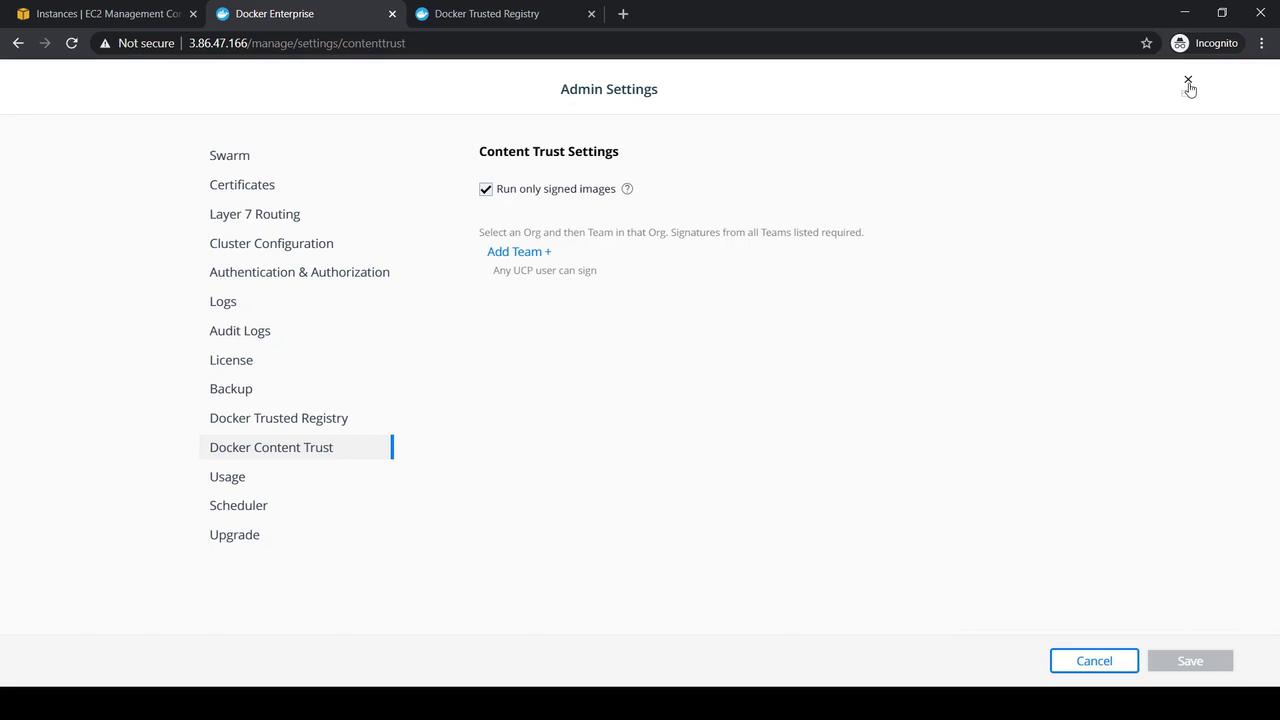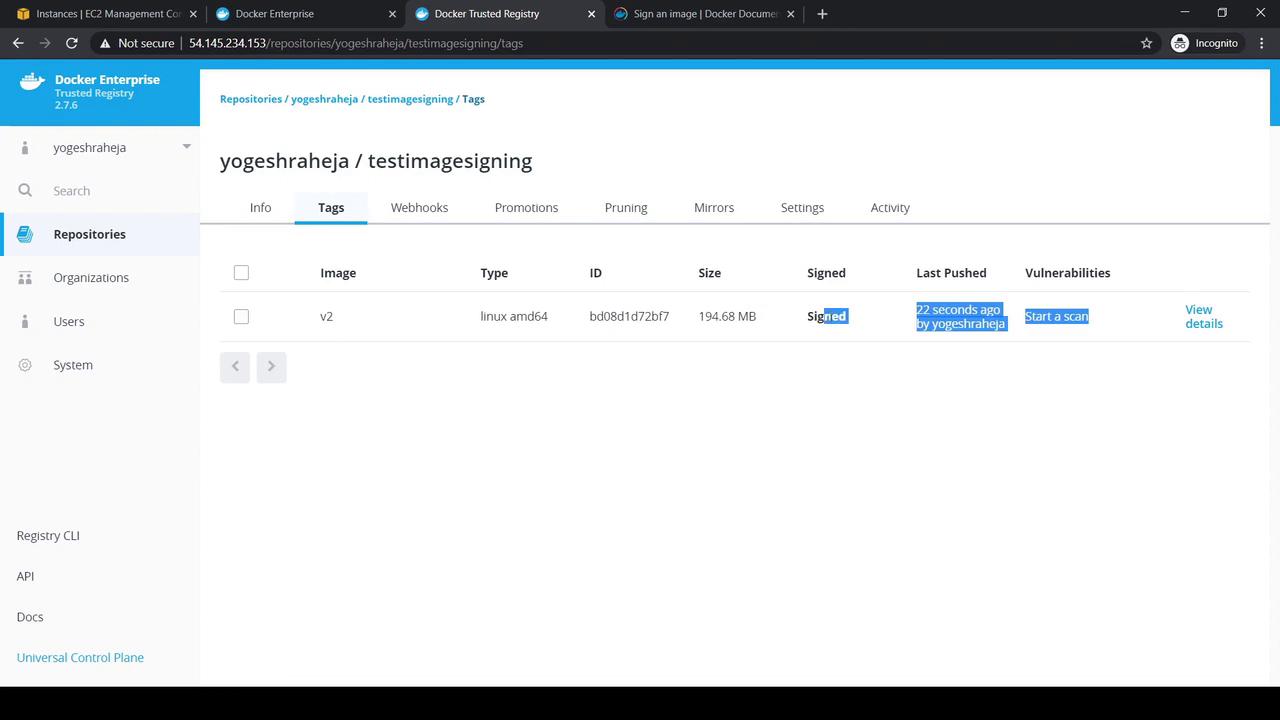Docker Certified Associate Exam Course
Docker Trusted Registry
Docker Content Trust and Image Signing
In this guide, you’ll learn how to configure Docker Content Trust (DCT) to allow only cryptographically signed images in your environment. We cover:
- Pulling unsigned images without Content Trust
- Enabling Content Trust on an individual host
- Enforcing Content Trust across a UCP cluster
- Pushing unsigned images to Docker Trusted Registry (DTR)
- Managing Notary keys and signing images
- Verifying and pulling signed images
Step 1: Pulling an Unsigned Image (without Content Trust)
On a UCP worker node, list existing images and pull the unsigned image yogeshraheja/tomcatone:v1 from Docker Hub:
[root@ucpworker ~]# docker image ls
REPOSITORY TAG IMAGE ID CREATED SIZE
docker/ucp-pause 3.2.6 feb0e469f6ac 2 months ago 683kB
docker/ucp-agent 3.2.6 b9763a5e7df8 2 months ago 62.1MB
docker/ucp-hyperkube 3.2.6 56c3b92d2b4f 2 months ago 441MB
docker/ucp-calico-node 3.2.6 40091fdbb1b4 2 months ago 189MB
docker/ucp-calico-cni 3.2.6 dd89cabc02dd 2 months ago 162MB
[root@ucpworker ~]# docker image pull yogeshraheja/tomcatone:v1
v1: Pulling from yogeshraheja/tomcatone
[...]
Status: Downloaded newer image for docker.io/yogeshraheja/tomcatone:v1
[root@ucpworker ~]# docker image ls
REPOSITORY TAG IMAGE ID CREATED SIZE
yogeshraheja/tomcatone v1 bd808d1... 5 days ago 497MB
Note
By default, Docker allows pulling unsigned images from public registries.
Step 2: Enabling Docker Content Trust on a Single Host
To require signed images, set the DOCKER_CONTENT_TRUST environment variable:
[root@ucpworker ~]# export DOCKER_CONTENT_TRUST=1
Remove the previously pulled image and attempt to pull it again:
[root@ucpworker ~]# docker image rm yogeshraheja/tomcatone:v1
[root@ucpworker ~]# docker image pull yogeshraheja/tomcatone:v1
Error: remote trust data does not exist for docker.io/yogeshraheja/tomcatone: notary.docker.io does not have trust data
Docker refuses to pull the unsigned image when Content Trust is enabled.
Step 3: Enforcing Content Trust Cluster-Wide via UCP
Manually exporting an environment variable on each node is tedious. Instead, enforce Content Trust across your Docker Universal Control Plane (UCP) cluster:
- Log in to UCP as an administrator.
- Navigate to Admin Settings → Account Settings.
- Enable Docker Content Trust (Only Signed Images).
- Save your changes.
This setting propagates DOCKER_CONTENT_TRUST=1 to all cluster nodes.

Step 4: Pulling an Unsigned Image from a Client with Content Trust Enabled
On your local workstation using the UCP client bundle, Content Trust is now enforced:
[root@yogeshclientbundle ~]# ./docker image pull yogeshraheja/tomcatone:v1
Error response from daemon: image or trust data does not exist for docker.io/yogeshraheja/tomcatone:v1
Warning
Disabling Content Trust exposes your environment to unsigned and potentially unverified images. Only unset if absolutely necessary.
To continue working with unsigned images temporarily:
[root@yogeshclientbundle ~]# unset DOCKER_CONTENT_TRUST
[root@yogeshclientbundle ~]# ./docker image pull yogeshraheja/tomcatone:v1
Step 5: Pushing the Unsigned Image to Docker Trusted Registry (DTR)
- In DTR, create a repository named
yogeshraheja/testimagesigning. - Tag and push the image from your local host:
[root@yogeshclientbundle ~]# ./docker image tag \
yogeshraheja/tomcatone:v1 \
54.145.234.153/yogeshraheja/testimagesigning:v1
[root@yogeshclientbundle ~]# ./docker login 54.145.234.153
Username: yogeshraheja
Password:
Login Succeeded
[root@yogeshclientbundle ~]# ./docker image push \
54.145.234.153/yogeshraheja/testimagesigning:v1
The repository now contains the unsigned image.
Step 6: Signing the Image with Docker Content Trust
Docker Content Trust uses Notary to manage trust metadata. Below are the steps to import your keys, initialize trust for a repository, and sign an image.
6.1 Import Your Notary Private Key
Copy the private key into Docker’s trust directory and load it:
[root@yogeshclientbundle ~]# mkdir -p ~/.docker/trust
[root@yogeshclientbundle ~]# cp key.pem ~/.docker/trust/
[root@yogeshclientbundle ~]# ./docker trust key load --name yogeshraheja key.pem
Loading key from "key.pem"...
Enter passphrase for new yogeshraheja key with ID 97dd9b8:
Repeat passphrase for new yogeshraheja key with ID 97dd9b8:
Successfully imported key from key.pem
6.2 Initialize Trust Metadata and Add a Signer
Authorize your user as a signer and initialize the repository’s trust data:
[root@yogeshclientbundle ~]# ./docker trust signer add --key cert.pub \
yogeshraheja \
54.145.234.153/yogeshraheja/testimagesigning
Adding signer "yogeshraheja" to 54.145.234.153/yogeshraheja/testimagesigning...
Initializing signed repository for 54.145.234.153/yogeshraheja/testimagesigning...
Enter passphrase for root key with ID 47caaa5:
Enter passphrase for new repository key with ID faf8bd5:
Repeat passphrase for new key with ID faf8bd5:
Successfully initialized and added signer "yogeshraheja".
6.3 Sign the Image Tag
Sign the v1 tag:
[root@yogeshclientbundle ~]# ./docker trust sign \
54.145.234.153/yogeshraheja/testimagesigning:v1
Enter passphrase for "yogeshraheja" key with ID 97dd9b8:
Signed 1 tag for 54.145.234.153/yogeshraheja/testimagesigning:v1
(Optional) Verify trust metadata:
[root@yogeshclientbundle ~]# ./docker trust inspect \
--pretty 54.145.234.153/yogeshraheja/testimagesigning
Step 7: Pushing Signed Images and New Tags
After signing, push your v1 image and optionally tag and sign a new version v2:
[root@yogeshclientbundle ~]# ./docker push \
54.145.234.153/yogeshraheja/testimagesigning:v1
# Tag a new version
[root@yogeshclientbundle ~]# ./docker image tag \
54.145.234.153/yogeshraheja/testimagesigning:v1 \
54.145.234.153/yogeshraheja/testimagesigning:v2
# Sign the new tag
[root@yogeshclientbundle ~]# ./docker trust sign \
54.145.234.153/yogeshraheja/testimagesigning:v2
# Push the v2 tag
[root@yogeshclientbundle ~]# ./docker push \
54.145.234.153/yogeshraheja/testimagesigning:v2

Summary Table of Content Trust Configuration
| Action | Method | Command / UI Path |
|---|---|---|
| Enable Content Trust on host | Environment variable | export DOCKER_CONTENT_TRUST=1 |
| Enforce Content Trust cluster | UCP Admin Settings | Admin Settings → Account Settings → Docker Content Trust |
| Import Notary key | CLI | docker trust key load --name <user> key.pem |
| Initialize repository signing | CLI | docker trust signer add --key cert.pub <user> <repo> |
| Sign an image tag | CLI | docker trust sign <repo>:<tag> |
Links and References
Watch Video
Watch video content